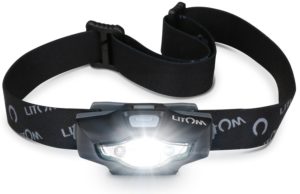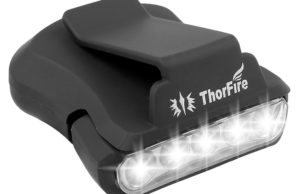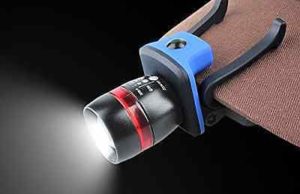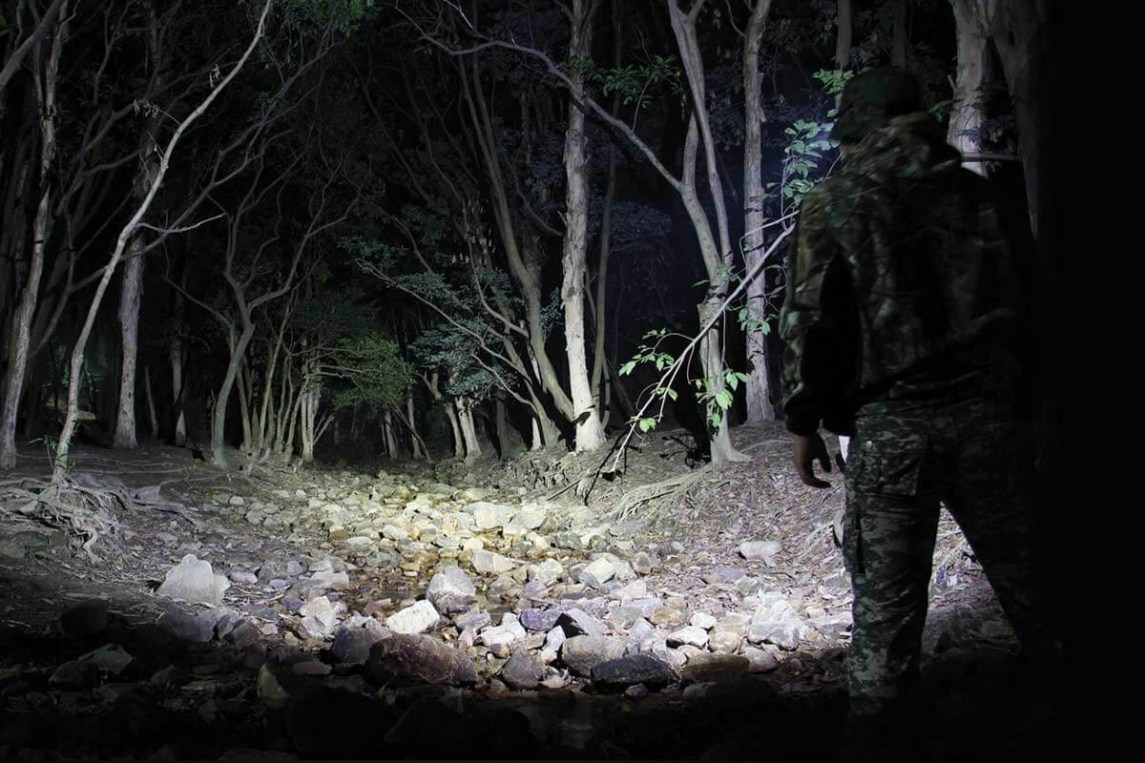
When I say “hands-free light” I mean a miner/caver style headlamp or a clip-on cap light. I don’t mean a lantern or any equivalent. Lamps and lanterns have their place, just like the good ol’ portable spotlights and flashlights that also live in my house. However, when it comes to a portable light, it’s hard to beat something that leaves your hands free and moves around with your eyes. Their cost, usefulness, and weight make them an absolute must-have for preppers.
Different Types of Headlamps
There are two general types of headlamps. There’s the “miner” or “caving” style with a strap or two like this one:
Then there are the clip-on “cap light” types that rides on a hat brim like this one …
Both have some pro’s and con’s. Then there’s this guy, too, nearly a hybrid of the two:
ThorFire Cree LED Cap Light Headlamp 3 Modes Ball Hat Lamp Flashlight Adjustable Zoomable Headlamp 155 lumen
With any headlamp, quality matters. That is sometimes to regularly reflected in price. Cheap stuff is … well, routinely cheap.
I can find good Rayovac and Browning models at HAM fests and flea markets for $5-10. Not only is the price spot-on or lower than online, there are regularly examples out, so you can get a feel for how sturdy clips are, how scratchy/smooth the band is, how heavy they are to wear, and how easy the controls are to handle before you buy.
Headlamp Shopping Consideration: Battery Type
Different models run off different types of batteries. Most take standard AA or AAA batteries or specialty coin/button cell batteries of various diameters and power, with some caving/miner’s style running off of a 9 volt.
There are a few that run off of A23’s and periodically a “matchstick” 4A/AAAA pops in one of our pockets. Those and the button cells are not exactly sitting on every shelf.
Even if they’re not going to be the victims of any crazy pre-disaster or mid-disaster runs, I’m not going to be able to grab any if I don’t already have them should a natural or manmade disaster bears down on us. They’re also not particularly inexpensive, although some of them have pretty incredible lifespans, especially in an LED light that gets used for a few hours during dark seasons, and I haven’t found chargers for them sitting on many shelves in my neck of the woods (or at all, ever).
The more powerful the headlamp – miner/caver headlamp or clip-on cap light – the faster it will burn up those batteries. In some cases, that’s mitigated by a light running off of 3-4 batteries instead of two, and that starts getting pretty heavy on heads that aren’t used to hardhats or helmets.

Headlamps that run off common batteries are easier to keep powered. Headlamps with battery packs opposite the light source distribute the weight and are a little more balanced, but aren’t particularly great if you have long hair.
For a lot of my everyday purposes, I really like the slim, curving clip-on cap lights that use a button cell battery, even though it does use uncommon batteries. They’re lighter to wear and slimmer to stick in a pocket when I’m not wearing a hat.
However, for preparedness purposes and away-from-home headlamps, I stock up on the ones that run off one or two AAA batteries.
They’re still relatively lightweight, and AAA is a common size for us. I have plenty of chargers, and rechargeable and disposable batteries for them, to include some that stay in my truck with a mini solar window charger. That means I can afford more batteries and I have more options for battery sources, so I can keep them fed longer than if I relied on a less-common or specialty battery.
There’s also less aggravation involved when a battery gets replaced, and then a light immediately dies a hero’s death (or an inglorious one; we’re a family of klutzes).
For people who prepare for the worst, how much money and what percentage of a supply is invested in any given risk is something to consider. After all, our plans should always include a visit by Uncle Murphy.
Shopping Consideration: Light & Switch Array
I prefer the kind where the light options are one-click selectable instead of progressive click types, but I’m learning to look down and shade them with a palm before I touch them.
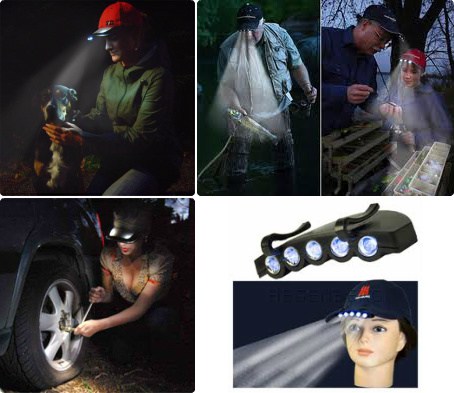
Some clip-on cap lights have progressive-click single-button controls that require running through various light intensities, colors and-or flashing sequences to turn them off. Some are available with one-click select-able settings.
Why is this a factor?
Because it’s rude to blind people, horses, and dogs whose vision has adjusted, especially if you love them. Sometimes it’s only as annoying as living with somebody who doesn’t close cabinets or drawers, but sometimes it’s really a bad time to have your rods and cones flip-flop and your pupils tighten to a pinpoint.
Being able to just automatically go from a low light to “off” also has advantages at bedtime.
Some of us are sensitive to sudden light increases, even when we’re aware it’s coming. Closed eyes are not always barrier enough. When we’re done reading and ready for bed, but have to progress through three colors or 3-5 intensities of light to turn a lamp off, we have a real potential to wake ourselves back up or disturb loved ones or partners. That’s bad enough on a camping trip or for a short-term outage. It’s the kind of thing that can become a constant bur under the saddle and lead to tempers and serious discontent in high-stress situations.
Hands-free flashlights are supposed to be making our lives easier, not harder. It’s not an insurmountable problem (hence, learning to hold a hand over the LEDs); it’s just something to be aware of when we buy. If we’re forgetful or only have one good paw, maybe we make sure to buy the selective-setting versions with a separate on-off switch, or that we buy ours with just one light setting. Lots of options.
Headlamp Pro-Cons by Style
As I said, I really like the flatter clip-on styles over the caving/miner style of headlamp.
They fit in back pockets of jeans and coat pockets very easily and without snagging everything else in there in winter. They’re light enough to clip to my stove hood and to lampshades during outages, to a branch or fence wire while grilling, or to a pack strap sitting at a campsite, and to clip to my shirt or coat collar if I’m wearing a ski cap or bandana instead of a hat.
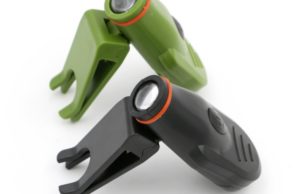
There are clip-on cap lights with single optics and that prop up or rotate for convenience. They lose some of the drawbacks of a miner style headlamp, but they can weigh just as much and drag a hat down – which is a real pain if you wear glasses.
I’m also a chick, and the miner’s strap types snag my hair. That then gets in my way until I stop and re-band it. This is annoying when my hands are wrist-deep in raw meat, starchy potatoes, or garden soil.
When I’m wearing them without a hat, they rub my forehead uncomfortably. They’re a little bit heavier and a little bit bulkier, and you have to adjust multiple straps. They also give me one more length of strap to be snagging on things. Those annoyances add up when you’re already uncomfortable.
However, they, too, have their advantages.
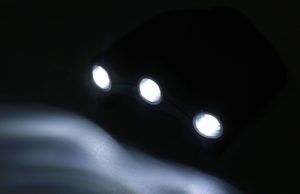
There are some powerful cap lights available, but for the same price, there is usually a caver/miner style headlamp that penetrates further or illuminates a wider area.
I can find more powerful lights that penetrate deeper into space without extreme costs in the miner’s/caving style of headlamp. It’s kind of their wheelhouse, after all. I can think of a lot of situations where that added distance has a real advantage.
As with the clip-ons, I can find versions with variable light distance and area coverage, and with the miner’s style, I can sometimes find them Maglite style, where twisting a ring lets me condense to a narrow point or open up to a wider area. That’s pretty convenient sometimes, and the rings tend to hold up well to years of use.
I tend to find the caver’s and miner’s style sturdier and more resistant to boots and bouncing down stairs than the clip on’s, even when they’re a lower-grade camping model.
We call them “nighttime collars” for the pups because we sling them on before we turn the pack loose in low-light situations.
With a handy clothespin or a wire clothes hanger, they can be used in just as many places around the house as the cap lights. The strap has periodically gotten looped around my neck or arm, I can hook them around pack straps to keep track of those while setting up camp (and of the nephews and BSA kiddos in front of me when we’re running late into a site), and I can hang them on my rear-view mirror easily instead of clipping a light to the sun visor.
Which is better? It’s really just a matter of preference, and sometimes preference changes just by use. I have both, just like I own both firearms and airguns.

Image/Images: There are a lot of times when it’s not just nice to have a light follow our eyes without holding it in our hands – it greatly effects our efficiency and speed.
Hands-Free Lights – A Must-Have? Really?
Yeah. Because it’s dark out there. Most of us never truly know how dark it can be, even when we’re rural dwellers and backpackers, because there’s so much ambient light in most of North America. One of the big adjustments for non-camping suburban and city folks is just how dark a rural area can be – even with its household lights from electronics and appliances.
Long-term outages and a grid-down situation will change that, and potentially remove most or all of those constant glows from our lives. So light sources belong on any must-have list.
Especially in the dark, it’s really nice to have a light while working with my hands. Yes, there are all kinds of lanterns. I have quite the variety. Lamps and lanterns have to be carried around. That takes a hand, or requires fetching them. Other light sources are fixed and I have to move to them with tasks. That’s limiting my efficiency one way or another.

Cooking is one of those times when a lamp doesn’t always cut it and it’s nice to have the light turn with our heads.
When I’m sitting somewhere reading, playing cards, or cleaning a tool, a lantern works great.
When I’m moving around cleaning, cooking, filing animal nails and feet, going from the back to the front of my truck and somebody else’s vehicle miracling one of them to life, or doing chores in darkness, it’s really nice to have a light that moves with me and leaves me with both hands free.
When I’m walking the dogs, hauling game to a vehicle or home, or chipping/brushing/shoveling our vehicles free from winter’s grasp, a light that follows me around without adding much bulk, weight, or effort on my part is definitely worth the price of somebody’s fancy coffee or Big Mac meal.
Since headlamps are so affordable, and since they have the potential to increase my efficiency so much over having to cart a lamp or lantern around with me, since they take up so little room in storage for their backups and backup power sources, and since those power sources and chargers cross with so many other devices … for me, hands-free flashlights are absolutely a must-have item.
In bulk, if I’m a bartering type, because they’re just that useful in an outage and off-grid environments of all kinds.
Other self-sufficiency and preparedness solutions recommended for you:
Healthy Soil + Healthy Plants = Healthy You
The vital self-sufficiency lessons our great grand-fathers left us
Knowledge to survive any medical crisis situation
Liberal’s hidden agenda: more than just your guns
Build yourself the only unlimited water source you’ll ever need
4 Important Forgotten Skills used by our Ancestors that can help you in any crisis


